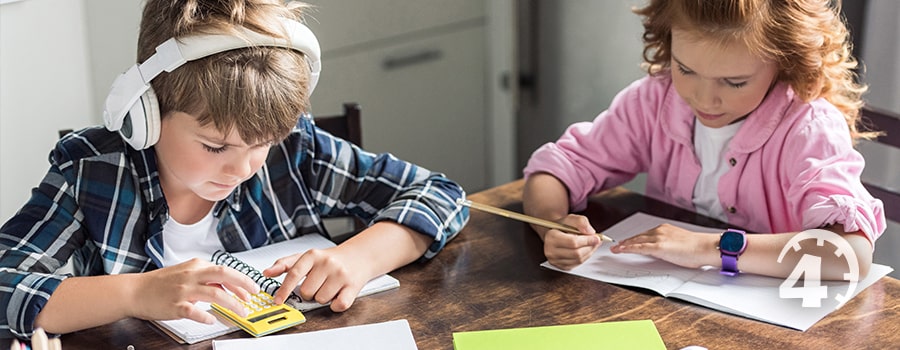Using Different Learning Styles in Homeschooling

The idea of different learning styles started to gain popularity in the mid-70’s. Since then, the notion has influenced the way education and learning is perceived. Just like there are different teaching methods, many individuals also believe there are different ways to learn and understand new information.
Despite facing many challenges, many parents started looking into the different ways of learning and assessing their child’s preferred learning method. Time4Learning has proudly served parents of struggling students who are looking into homeschooling as an educational alternative for the first time. We recommend learning more about the types of learning styles and how your child learns best. Then, discover How Time4Learning Works to see if we are a good fit for your family.
Jump to the sections below to understand a bit more about the different types of learners:
How do Children Learn?
Every child has different learning preferences. Some prefer to learn by seeing or hearing, others by doing, some by reading, and others by asking questions. One thing all students have in common is that they all learn best when they incorporate items and topics that interest them into their studies.
While your child may fit more than one learning style, you may notice patterns in their learning preferences. For example, a visual learner may also be a very social and verbal learner who prefers to learn especially difficult topics using their primary communication skills.
Understanding how your child learns is one of the best ways to gain the most from their homeschool experience and choose the best curriculum for your family. As new homeschoolers get started, we recommend going through what’s called the deschooling process, a transitional period that allows you and your child to hit the ‘reset’ button and let go of any preconceived notions of what learning should look like. Additionally, you can take this time to understand your child’s learning style.
What Are the Different Learning Styles?
There are seven main learning styles:
Visual (spatial) Learner
Visual learners are those who prefer learning by observing things. Using visual aids such as pictures, images, diagrams, and whiteboards help these learners understand information better. They easily visualize information, have a good sense of direction and usually like to draw and doodle. Learn more on our Visual Learner page.
Aural (auditory) Learner
Sound and music appeal to these learners who typically have a good sense of rhythm. These learners are usually singers or musicians who are familiar with different instruments and the sounds they make. Aural learners are good listeners who normally learn best through verbal presentations like lectures and speeches. Learn more on our Auditory Learners page.
Verbal (linguistic) Learner
These learners prefer using words, both in speech and writing. They can easily express themselves and usually love to read and write. Verbal learners tend to have a vast vocabulary and excel in activities that involve speaking, debating, and journalism. Learn more on our Verbal Learning page.
Physical (kinesthetic) Learner
Whether it’s by using their body or hands, these learners are all about the sense of touch. Physical activities and sports play a big part in these student’s lives. Getting hands-on is a must for these learners who love to tinker and learn best when they can do rather than see or hear. Learn more on our Kinesthetic Learning page.
Logical (mathematical) Learner
If there is logic, reasoning, and numbers involved, these learners are sure to excel. These students function and solve complex problems by employing strategies and a scientific way of thinking. Computer programming, math, and science are usually favored by these types of learners. Learn more on our Logical Learning page.
Social (interpersonal) Learner
Learning in groups and working with others is favored by social learners. These students know how to communicate effectively and enjoy collaborating with others, brainstorming, and discussing ideas and concepts. Social learners are generally good listeners who are thoughtful and understanding. Learn more on our Social Learning page.
Solitary (intrapersonal) Learner
These students prefer to use self-study and work alone. They are independent, very self-aware, and in tune with their thoughts and feelings. These learners prefer being away from crowds and learn best in a quiet place where they can focus on the task at hand. Learn more on our Intrapersonal Learning page.
Try Time4Learning Risk Free!
- PreK-12th Online Curriculum
- 24/7 Access to 3,500+ Lessons and Activities
- Automated Grading & Reporting
- Activity Planner for Easy Scheduling
- Start, Stop, or Pause Membership Anytime
Time4Learning Works For Different Types of Learners
Time4Learning has developed a comprehensive, multi-modality learning curriculum that allows all students to reach successful levels of understanding no matter what their preferred learning style is. Time4Learning helps parents track student progress and helps children advance through individualized learning paths. Our lessons are designed to meet a vast array of learning needs. This ensures complete coverage of the needed skills and concepts to ensure success.
Here is a list of ways different types of learners benefit from our award-winning online curriculum.
- Animated and interactive lessons keep different types of learners engaged.
- Our curriculum offers a wide selection of written and spoken materials for those who learn best by listening, speaking, reading, and writing.
- Numerous free printables are available for those who love learning hands-on.
- Students can pause lessons to either take notes, draw representations or listen to verbal instructions again depending on their learning style.
- Interactive activities help auditory and verbal learners understand concepts and ideas.
- Flexible learning options mean kinesthetic learners don’t have to sit at a desk all day. They can learn through field trips, science experiments, and offline activities.
- Comprehensive math and language arts curriculum allow verbal and logical learners to excel with access to multiple grade levels.
- A student-paced approach allows solitary and independent learners to work when and where is most convenient for them.
- Connect with others in the homeschooling community on our Families Facebook Group to make social learning possible!














